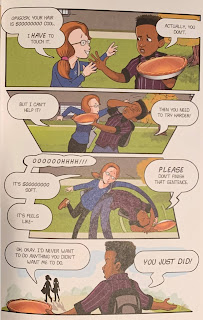New Kid was a landmark book, the first graphic novel to win the Newbery Award. This follow-up is called a "companion" to that book, because it is not so much a sequel as it is a continuation of the story. It still follows the life of Jordan Banks, now in his second year at Riverdale Academy Day School, a very sheltered private school in the Bronx. Jordan still wants to be an artist and is struggling with his parents about applying to an arts-focused school. But this book also takes a larger focus on his classmate Drew Ellis, one of the the other African-American students at RAD, who has a different set of concerns.
Just like with New Kid, Drew deals with the subtle and overt sorts of racism that pervade life at RAD. He is more athletic and popular than Jordan, though he won't go out for the basketball team because he does not want to be seen as a stereotype. He also has relationship issues, as he gets a girlfriend named Ashley, who tries to impress him with a constant stream of baked goods. She keeps baking him sweet potato pies, which makes him uneasy because it's well intended but also racist. She, and other kids, insist on touching his hair, which really makes him uneasy when they totally ignore his telling them not to.
Drew also gets singled out to lead a tour of students from their new "sister school" Cardinal De Bard Junior High School in the south Bronx, because he "looks more" like the students there. This makes him pause because it's a place close by Jordan's house, so he would seem to be a better choice, but the teacher organizing this relationship (a white man) thinks that the visitors will be more comfortable with the darker-skinned Drew.
This theme of exchange runs throughout the book, first in the school visit, but later when Jordan and Drew visit the home of their ultra-rich classmate Liam over the Thanksgiving break. Liam's house is huge, he owns all the video games, and his family insists on eating weird, overly-crunchy flatbread pizza, so the two boys feel like they are in a different world. They also wonder if they could ever truly be friends with someone whose life is so different from their own. Later still, Liam visits Jordan's house, eats a variety of different sorts of food, and gets to hang out with other kids at the local rec center. Although all the boys live in the same borough, it seems like they live in different worlds, though they start to learn to appreciate where the other is from.
What is impressive about this book is how well it brings out issues of race in relatable and moving ways that are not utterly overt or
didactic. Part of this characteristic lays in the artwork, which is colorful and inviting. It also rewards fans of comics and graphic novels, with chapter breaks that reference popular books like This Was Our Pact, Hey Kiddo, and Real Friends as well as other popular media. This book is fun, full of visual puns (especially with
local businesses and signage) and witty repartee that make the book feel human and realistic. I particularly like
Jordan and Drew's game of calling each other by different, inventive
names, a playful way of addressing the fact that many of the teachers at
the school constantly confuse them or forget their names. And the supporting cast is very strong, from the frequently misguided teachers at RAD to the pesky Andy, who tries too hard to fit in, to the fantastic Alexandra, a strange and wise girl who definitely walks to the beat of her own drummer. Dispensing wisdom from a hand puppet, she is the Yoda/Silent Bob of this book, and one of my favorites because she appears so comfortable with who she is.
In many ways, this is a book about experiences in middle school, full of big questions and the unease of finding one's way in the world. Certainly, today that also includes navigating systems of institutionalized inequality and racism. And it is not utterly dismissive about what it satirizes, even the consistently tone-deaf attempts by the RAD administration to address racism. It offers no pat answers, but it does put human faces to this very important conversation.
Jerry Craft wrote and drew this book. In addition to New Kid, he has drawn multiple children's books and graphic novels, mostly based on his comic strip Mama's Boyz. He speaks extensively about his work on Class Act in this interview.
All of the reviews I have read of this book have been positive. Esther Keller advised, "Librarians should stock up on as many copies as they can." Kirkus Reviews gave it a starred review that concluded (with a pun even!), "A well-Crafted, visually rich, truth-telling tale for our troubled times that affirms the eternal importance of friends." In another starred review, Publishers Weekly wrote, "Deftly weaving discussions of race, socioeconomics, colorism, and
solidarity into an accessible narrative, Craft offers a charming cast
journeying through the complicated landscapes of puberty,
self-definition, and changing friendships, all while grappling with the
tensions of attending an institution that structurally and culturally
neglects students of color."
Class Act was published by Quill Tree Books, and they offer a teachers guide and more info about it here.


No comments:
Post a Comment